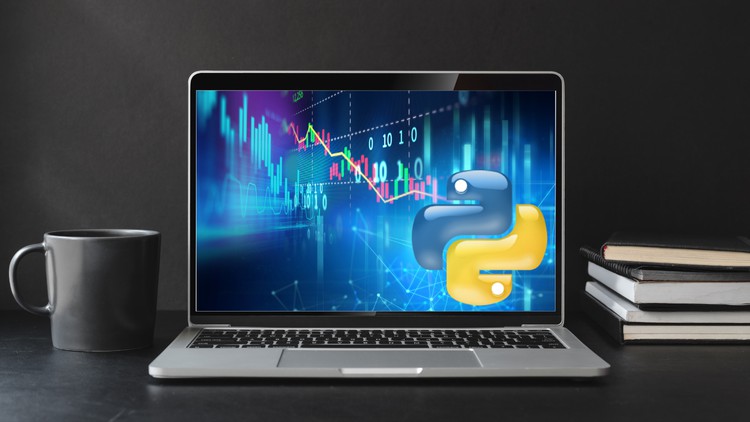Python for Finance: Financial Analysis for Investing
- Description
- Curriculum
- FAQ
- Reviews
Did you know that the No.1 killer of investment return is emotion?
Investors should not let fear or greed control their decisions.
How do you get your emotions out of your investment decisions?
A simple way is to perform objective financial analysis and automate it with Python!
Why?
-
Performing financial analysis makes your decisions objective – you are not buying companies that your analysis did not recommend.
-
Automating them with Python ensures that you do not compromise because you get tired of analyzing.
-
Finally, it ensures that you get all the calculation done correctly in the same way.
Does this sound interesting?
-
Do you want to learn how to use Python for financial analysis?
-
Find stocks to invest in and evaluate whether they are underpriced or overvalued?
-
Buy and sell at the right time?
This course will teach you how to use Python to automate the process of financial analysis on multiple companies simultaneously and evaluate how much they are worth (the intrinsic value).
You will get started in the financial investment world and use data science on financial data.
———————————————————————–
Why should you enroll in this course?
-
Making investment decisions is like playing poker without looking at your cards if you don’t know what you are doing.
-
You don’t want to stocks in a company you did not analyze first.
-
This is the only course that takes you through the full process from finding attractive investments and how to time your first buy.
-
Similarly, you do not buy a house without looking at the condition report.
-
How to see if a company will grow in value, to avoid falling stock prices the day after you buy it.
-
This course does not assume you have a portfolio and want to optimize it – it will help you find the stocks to invest in first.
-
It gives you a solid foundation to invest with confidence and stop gambling.
-
Learn that making financial analysis on companies is not that difficult and can be automated with Python.
-
The market crashed in 2020 without any warning – some companies came in quickly, others did not.
-
Be sure to invest in companies with a solid economy and a growth market.
———————————————————————–
How is this course structured?
-
This course will guide you through how to install the necessary software (Anaconda) – it’s all free.
-
It will cover how to use Jupyter Notebook (from Anaconda package) if you are not completely familiar with it.
-
A crash course in Python if you need an update or come from a different programming background.
-
Then it starts by introducing financial concepts along with Python programming to fully understand them.
-
This includes understanding of stocks, volume, dividends, returns, market price, price to earnings (EPS), price to earnings (PE ratio), book value and more.
-
A deep introduction to Pandas, the most important library used for financial analysis with Python.
-
It will cover DataFrames, Series, read and write data, export to Excel, merge, join and link data and much more.
-
The concept of intrinsic value (a fair stock price to pay) – this is the most important concept to understand when investing.
-
How the risk of investment is understood and how to assess it for a company.
-
This is how the management of a company is assessed in an objective way.
-
This will include learning about debt-to-equity ratio (DE ratio), current assets, return of investment (ROI), revenue evaluation, earnings per share (EPS) evaluation, book value evaluation, free-cash-flow (FCF) evaluation and more.
-
This teaches you how to calculate a fair price (intrinsic value) to be paid for a company.
-
Matplotlib is introduced and how it can be used to visualize data for efficient data interpretation.
-
We visualize data and export it to color-formatted Excel sheets – all from Python.
-
You will learn to use free APIs to read up-to-date data on stock quotes and financial statements.
-
Then we dive deeper and work with historical time series data on stock prices.
-
This teaches you rate of return, percentage change, and normalization.
-
How to calculate and use the Compound Annual Growth Rate (CAGR).
-
There will be a case study on DOW theory.
-
Next, we will examine and calculate technical indicators such as moving averages (MA), MACD, stochastic oscillator and RSI, and how to use them to buy and sell.
-
We introduce NumPy to perform further analyzes.
-
This will help us calculate and understand the volatility of a stock.
-
Also, correlation between stocks, linear regression, beta, CAPM, and more.
-
How to work with a full portfolio.
-
This includes concepts like Sharpe ratio, Monte Carlo Simulation, Efficient Frontier and more.
———————————————————————–
This course has
-
21 hours of video in 180+ lectures.
-
Exercises are prepared in Jupyter Notebooks.
-
Links to useful resources along the way.
-
Explains all concepts in an easy way with real examples.
Udemy has a refund guarantee with a 30 day money back guarantee that ensures if you are not satisfied, you will get your money back. Also, feel free to contact me directly if you have any questions.
———————————————————————–
About the instructor
Rune is a Ph.D. in computer science with a background in Python programming. He has taken an MBA from Henley Business School in the UK to study business administration and economics. Rune has been teaching programming and computer science since college. He has other best-selling courses at Udemy.
-
1One QuestionVideo lesson
What is a good investment and what is a bad investment?
Can you see that from the stock price?
You need technical indicators?
Will that help you from a market crash?
Learn about intrinsic value and how to use it.
-
2Get the most out of this courseVideo lesson
How to get the most out of the course?
We will cover the following.
Who is the course for?
What to expect?
What resources are available?
-
3IntroductionVideo lesson
Introduction to the section.
-
4Download Anaconda (includes Python and Jupyter notebook)Video lesson
In this lecture we will download Anaconda.
Anaconda includes
Python
Jupyter notebook
In the resources is a link where to download the FREE version of Anaconda and how to install it on your platform.
After this lecture you should have all needed installations on your system running.
-
5Resources and setup environment in Jupyter notebookVideo lesson
Download the the resources, it includes.
All the source code in notebooks.
Exercises for the sections.
How to setup the environment
Two ways to ensure correct libraries are installed.
Make sure to follow this to get the same experience in the course.
-
6IntroductionVideo lesson
Introduction to the section.
Also attached is the Jupyter Notebook Cheat Sheet if you are not used to work in it.
-
7Jupyter Notebook: The DashboardVideo lesson
Learn about the Dashboard in Jupyter Notebook.
You will learn how to
Create folders
Upload Notebooks
Create Notebooks
See running Notebooks.
Feel free to skip this lecture if you are familiar with Jupyter Notebook.
-
8Jupyter Notebook: Run and restart a NotebookVideo lesson
Learn how to Run and restart a Notebook.
You will learn how to:
How to execute a cell with code
Stop a running cell in Jupyter Notebook.
Restart and clear the output in a Notebook.
Feel free to skip this lecture if you are familiar with Jupyter Notebook.
-
9Jupyter Notebook: Copy and reorganize codeVideo lesson
In this lecture you will learn how to:
Copy code cells
Reorganize the code cells
Delete code cells.
Feel free to skip this lecture if you are familiar with Jupyter Notebook.
-
10Jupyter Notebook: Comment and markdownVideo lesson
In this lecture you will learn:
How to insert comments in your code cells.
How to insert markdown cells with description
Feel free to skip this lecture if you are familiar with Jupyter Notebook.
-
11Jupyter Notebook: Tab + Tab + Shift & TabVideo lesson
In this lecture you will learn:
How to autocomplete code in Jupyter Notebook.
How to list all methods available in an object.
How to get the documentation of a method.
Feel free to skip this lecture if you are familiar with Jupyter Notebook.
-
12What did we learn?Video lesson
After this section you should be ready to use Jupyter Notebook.
-
13IntroductionVideo lesson
In this section we will have a Python crash course.
It will cover all the basics needed to be at the level of Python needed.
This section is ideal for you:
If you are new to Python, but have experience from another programming language.
If you need a refresher on Python.
If you are new to programming - this is get you an idea about programming. But don't expect to master it after this.
Feel free to skip this section if you are familiar with Python basics.
-
14Variables and typesVideo lesson
In this lecture we will learn about.
Variables in Python.
The types of variables.
-
15The print statementVideo lesson
In this lecture you will learn about:
How to use print in the most convenient way.
-
16Boolean expressionsVideo lesson
In this lecture we will learn about:
Boolean expressions.
How they are the most important aspect of programming.
Without them, programs would have no real benefits.
Understand how they are evaluated by the computer.
How everything is either-or for a computer.
-
17If statementsVideo lesson
In this lecture we will learn:
That actually, Boolean expressions are useless without if-statements.
How they are connected together.
How to use if-statements.
-
18Python listsVideo lesson
In this lecture we will learn:
About Python lists, which is a powerful data structure that is easy to use.
How to construct lists.
How lists are generic.
-
19For-loopsVideo lesson
In this lecture we will learn:
How to iterate and do the same task for many items.
How to loop over a list.
They are used together with Pandas and are important to understand.
-
20While loopsVideo lesson
In this lecture we will learn:
How to iterate and have a Boolean expression determine when it is done.
How while-loops are different form for-loops.
-
21Python Dictionaries (dict)Video lesson
In this lecture we will learn:
The dictionary (dict)
A powerful data structure in Python.
They are used together with Pandas and are important to understand.
-
22Other typesVideo lesson
In this lecture we will learn:
About sets and when they are used.
Tuples and how we use them implicitly all the time.
-
23FunctionsVideo lesson
In this lecture we will learn about:
About python functions.
A great way to structure code.
-
24Lambda functionsVideo lesson
What is a lambda function?
Exactly.
We will learn what a lambda function is.
That a lambda function is a nameless function.
How to transform a function to a lambda function.
-
25ExercisesVideo lesson
These exercises are good to train and refresh your Python skills.
-
26SolutionsVideo lesson
The solutions to the exercises from last lecture.
-
27New to Python? We have all been thereVideo lesson
My own and others experience with learning to program.
It is often easy to read code, but difficult to write your own code.
-
28What did we learn?Video lesson
This section covers the basics of Python programming.
-
29IntroductionVideo lesson
This section will cover the beginning to understand investing.
It will cover the all the core concepts, which are important to understand a company and how to value it.
The story line will be around a Lemonade Stand. This makes it easy to understand, but we will also calculate concrete examples with Python in Jupyter Notebook.
The key concepts covered are:
Intrinsic value
Market value
Book value
Shares
Dividend
-
30Intrinsic ValueVideo lesson
Short overview of the concepts.
Intrinsic value
Market value
Book value
Shares
Dividend
-
31Introduction to the Lemonade StandVideo lesson
We will be introduced to how the the story of the Lemonade Stand will help us understand the key concepts.
-
32The Lemonade Stand - the easy to understand exampleVideo lesson
The story of the Lemonade Stand.
Sets the main question in investing:
What is it worth?
This is not simple to answer as it will show.
-
33Jupyter Notebook: The Lemonade StandVideo lesson
In this lecture we will calculate in Jupyter Notebook to understand the concepts from last lecture.
-
34SharesVideo lesson
Understand what Shares are?
How shares determine the price - or market value.
What shares outstanding are.
-
35Shares a story - Understand what they really areVideo lesson
In this lecture we will continue the story of the Lemonade Stand.
This will connect it to:
Shares
Shares outstanding.
Market price
How shares affects the market price.
-
36Jupyter Notebook: SharesVideo lesson
In this lecture we will calculate in Jupyter Notebook to understand the concepts from last lecture.
-
37DividendVideo lesson
Dividend connects to more concepts.
Earnings per share (EPS)
Price/Earnings (PE) ratio
Volume
Yield
We will cover that along with what dividend is.
-
38Dividend a story - an easy way to understand themVideo lesson
We will continue the story of the Lemonade Stand to ensure we understand the following concepts.
Dividend
Earnings per share (EPS)
Price/Earnings (PE) ratio
Volume
Yield
-
39Jupyter Notebook: DividendVideo lesson
In this lecture we will calculate in Jupyter Notebook to understand the concepts from last lecture.
-
40What did we learn?Video lesson
After this section you should understand the key concept of value investing.
Intrinsic value
Also, understand that it is not easy to calculate it - there are no direct financial values determining it.
This understanding is crucial to continue the course and calculate an objective value for the intrinsic value and ensure we do not make wrong investments.
This section included concepts:
Intrinsic value
Market value
Book value
Shares
Dividend
Earnings per share (EPS)
Price/Earnings (PE) ratio
Volume
Yield
-
41IntroductionVideo lesson
-
42Introduction to Pandas - a small demonstrationVideo lesson
-
43SeriesVideo lesson
-
44DataFrames - Part IVideo lesson
-
45DataFrames - Part IIVideo lesson
-
46DataFrames - Part IIIVideo lesson
-
47DataFrames - Part IVVideo lesson
-
48DataFrames - Part VVideo lesson
-
49Read and Write with Pandas - Part IVideo lesson
-
50Read and Write with Pandas - Part IIVideo lesson
-
51Read and Write with Pandas - Part IIIVideo lesson
-
52Merge - Join - Concatenate - Part IVideo lesson
-
53Merge - Join - Concatenate - Part IIVideo lesson
-
54Transpose and clean dataVideo lesson
-
55ViewsVideo lesson
-
56Useful methods to knowVideo lesson
-
57Apply - an awesome method to masterVideo lesson
-
58ExercisesVideo lesson
-
59SolutionsVideo lesson
-
60What did we learn?Video lesson
-
61IntroductionVideo lesson
-
62Outcome of sectionVideo lesson
-
63Understand Risk - Part IVideo lesson
-
64Understand Risk - Part IIVideo lesson
-
65Understand Rik - Part IIIVideo lesson
-
66Understand Risk - All put togetherVideo lesson
-
67Evaluate LeadershipVideo lesson
-
68Debt-to-Equity ration - EvaluationVideo lesson
-
69Jupyter Notebook: Debt-to-Equity ratioVideo lesson
-
70Current ratio - EvaluationVideo lesson
-
71Jupyter Notebook - Current ratioVideo lesson
-
72Stable and predictableVideo lesson
-
73Return of Investment (ROI) - EvaluationVideo lesson
-
74Jupyter Notebook: Return of InvestmentVideo lesson
-
75Revenue - EvaluationVideo lesson
-
76Jupyter Notebook: RevenueVideo lesson
-
77Earnings Per Share (EPS) - EvaluationVideo lesson
-
78Jupyter Notebook: Earnings Per Share (EPS)Video lesson
-
79Book Value - EvaluationVideo lesson
-
80Jupyter Notebook: Book ValueVideo lesson
-
81Free Cash Flow (FCF) - EvaluationVideo lesson
-
82Jupyter Notebook: Free Cash Flow (FCF)Video lesson
-
83Combine All DataVideo lesson
-
84Jupyter Notebook: Combine All DataVideo lesson
-
85Calculate a Fair Price (Intrinsic Value)Video lesson
-
86Price-to-Earnings (PE) ratioVideo lesson
-
87Jupyter Notebook: Price-to-Earnings (PE) ratioVideo lesson
-
88Jupyter Notebook: Calculate a Fair Price (Intrinsic Value)Video lesson
-
89Compare it with Current PriceVideo lesson
-
90What did we learn?Video lesson

External Links May Contain Affiliate Links read more





